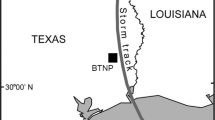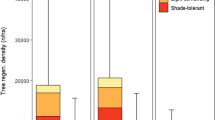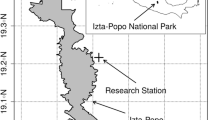Abstract
Windthrow is recognized as an extremely significant disturbance in many forests. Its effects are increased by stand fragmentation, which exposes the stand to strong winds. In this study, we investigated the change in tree mortality in fragmented stands with the distance from the stand edge, in a conifer–broadleaved mixed forest in northern Japan. We set out experimental plots having three stand sizes (400, 1,600, 6,400 m2) and examined the stand dynamics over 10 years. Tree mortality tended to be higher in smaller stands, although an effect of stand size was found only in the first 5 years of the study. Distance-dependent individual mortality was obvious in Abies sachalinensis, the most vulnerable major tree species, again in the first 5 years, suggesting that wind-risk management should emphasize the area within ca. 20 m from the stand edge. No distant-dependent effect was found, however, in the latter 5 years, in which there was a strong typhoon; tree deaths occurred throughout the stand (irrespective of distance within) as a result of this event. We conclude that the severity of wind can cause the features of wind-induced damage to differ; stand edge effects peculiar to a small forest are unlikely to occur with particularly strong winds, and the effect of fragmentation might therefore be clear only in weaker disturbances.




Similar content being viewed by others
References
Achim A, Ruel JC, Gardiner BA, Laflamme G, Meunier S (2005) Modeling the vulnerability of balsam fir forests to wind damage. For Ecol Manag 204:35–50
Blackburn P, Petty JA (1988) Theoretical calculations of the influence of spacing on stand stability. Forestry 61:235–244
Canham CD, Papaik MJ, Latty EF (2001) Interspecific variation in susceptibility to windthrow as a function of tree size and storm severity for northern temperate tree species. Can J For Res 31:1–10
Dyer JM, Baird PR (1997) Wind disturbance in remnant forest stands along the prairie-forest ecotone, Minnesota, USA. Plant Ecol 129:121–134
Everham EM, Brokaw NVL (1996) Forest damage and recovery from catastrophic wind. Bot Rev 62:113–185
Foster DR, Boose ER (1992) Patterns of forest damage resulting from catastrophic wind in central New England, USA. J Ecol 80:79–98
Gardiner BA (1995) The interaction of wind and tree movement in forest canopies. In: Coutts MP, Grace J (eds) Wind and trees. Cambridge University Press, Cambridge, pp 41–60
Gardiner BA, Quine CP (2000) Management of forests to reduce the risk of abiotic damage—a review with particular reference to effects of strong winds. For Ecol Manag 135:261–277
Hiura T, Fujiwara K, Hojyo H, Okada J, Udo H, Okuyama S, Morita H, Fukuta H, Fujito E, Fukui T, Takahata M, Arikura K, Sugiyama H, Takeda T (1995) Stand structure and long-term dynamics of primeval forests in Nakagawa Experimental Forest, Hokkaido University. Res Bull Hokkaido Univ For 52:85–94 (in Japanese with English summary)
Ishikawa Y, Ito K (1989) The regeneration process in a mixed forest in central Hokkaido, Japan. Vegetatio 79:75–84
Jönsson MT, Fraver S, Jonsson BG, Dynesius M, Rydgård M, Esseen PA (2007) Eighteen years of tree mortality and structural change in an experimentally fragmented Norway spruce forest. For Ecol Manag 242:306–313
Mason WL (2002) Are irregular stands more windfirm? Forestry 75:347–355
Matlack GR (1994) Vegetation dynamics of the forest edge-trends in space and successional time. J Ecol 82:113–123
Mayer P, Brang P, Dobbertin M, Hallenbarter D, Renaud J-P, Walthert L, Zimmermann S (2005) Forest storm damage is more frequent on acidic soils. Ann For Sci 62:303–311
Mitchell SJ, Hailemariam T, Kulis Y (2001) Empirical modeling of cutblock edge windthrow risk on Vancouver Island, Canada, using stand level information. For Ecol Manag 154:117–130
Nicoll BC, Achim A, Mochan S, Gardiner B (2005) Does steep terrain influence tree stability? A field investigation. Can J For Res 35:2360–2367
Nicoll BC, Gardiner BA, Rayner B, Peace AJ (2006) Anchorage of coniferous trees in relation to species, soil type, and rooting depth. Can J For Res 36:1871–1883
Noguchi M, Yoshida T (2004) Tree regeneration in partially cut conifer-hardwood mixed forests in northern Japan: roles of establishment substrate and dwarf bamboo. For Ecol Manag 190:335–344
Noguchi M, Yoshida T (2009) Individual-scale responses of five dominant tree species to single-tree selection harvesting in a mixed forest in Hokkaido, northern Japan. J For Res 14:311–320
Papaik MJ, Canham CD (2006) Species resistance and community response to wind disturbance regimes in northern temperate forests. J Ecol 94:1011–1026
Peltola H, Kellomäki S, Vaisanen H, Ikonen VP (1999) A mechanistic model for assessing the risk of wind and snow damage to single trees and stands of Scots pine, Norway spruce, and birch. Can J For Res 29:647–661
Peterson CJ (2000) Damage and recovery of tree species after two different tornadoes in the same old growth forest: a comparison of infrequent wind disturbances. For Ecol Manag 135:237–252
Peterson CJ (2004) Within-stand variation in windthrow in southern boreal forests of Minnesota: is it predictable? Can J For Res 34:365–375
Peterson CJ (2007) Consistent influence of tree diameter and species on damage in nine eastern North America tornado blowdowns. For Ecol Manag 250:96–108
R Development Core Team (2008) R: A language and environment for statistical computing. R Foundation for Statistical Computing, Vienna, Austria. ISBN 3-900051-07-0. http://www.R-project.org
Rich RL, Frelich LE, Reich PB (2007) Wind-throw mortality in the southern boreal forest: effects of species, diameter and stand age. J Ecol 95:1261–1273
Rosenvald R, Lõhmus A, Kiviste A (2008) Preadaptation and spatial effects on retention-tree survival in cut areas in Estonia. Can J For Res 38:2616–2625
Ruel JC (2000) Factors influencing windthrow in balsam fir forests: from landscape studies to individual tree studies. For Ecol Manag 135:169–178
Saito S, Sato T (2007) Characteristics of typhoon damage to major tree species in a lucidophyllous forest: a comparison of tree species responses to several typhoons at the Aya long-term ecological research site. J Jpn For Soc 89:321–328 (in Japanese with English summary)
Saunders DA, Hobbs RJ, Margules CR (1991) Biological consequences of ecosystem fragmentation: a review. Conserv Biol 5:18–32
Scott RE, Mitchell SJ (2005) Empirical modeling of windthrow risk in partially harvested stands using tree, neighborhood, and stand attributes. For Ecol Manage 218:193–209
Tatewaki M, Igarashi T (1971) Forest vegetation in the Teshio and the Nakagawa District experimental forests of Hokkaido University, Prov Teshio, N. Hokkaido, Japan. Res Bull Coll Exp For Hokkaido Univ 28:1–192 (in Japanese with English summary)
Ulanova NG (2000) The effects of windthrow on forests at different spatial scales: a review. For Ecol Manage 135:155–167
Webb SL (1989) Contrasting windstorm consequences in two forests, Itasca State Park, Minnesota. Ecology 70:1167–1180
Yoshida T, Noguchi M (2009) Vulnerability to strong winds for major tree species in a northern Japanese mixed forest: analyses of historical data. Ecol Res 24:909–919
Yoshida T, Noguchi M, Akibayashi Y, Noda M, Kadomatsu M, Sasa K (2006) Twenty years of community dynamics in a mixed conifer-broad-leaved forest under a selection system in northern Japan. Can J For Res 36:1363–1375
Acknowledgments
We thank the staff of the Nakagawa Experimental Forest for their fieldwork. Thanks are also extended to Y. Ikegami and H. Shibata for their valuable comments on the early draft of the manuscript.
Author information
Authors and Affiliations
Corresponding author
About this article
Cite this article
Yoshida, T., Noguchi, M., Uemura, S. et al. Tree mortality in a natural mixed forest affected by stand fragmentation and by a strong typhoon in northern Japan. J For Res 16, 215–222 (2011). https://doi.org/10.1007/s10310-011-0274-5
Received:
Accepted:
Published:
Issue Date:
DOI: https://doi.org/10.1007/s10310-011-0274-5




